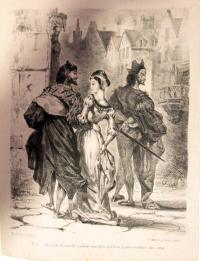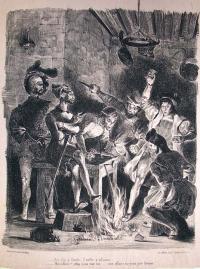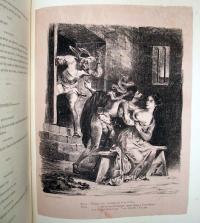Princeton University Library is fortunate to have acquired a superb copy of the 1828 illustrated edition of Goethe’s Faust, considered by most historians to be one of the finest publications of the nineteenth century. Gordon Ray calls Delacroix’s illustrations “the high point of Romantic book illustration,” and David Bland called the volume “one of the very greatest of all illustrated books.”
This copy survives in a particularly fine condition, with brilliant impressions of the lithographs printed on white, rose, blue, and light grey Chine collé. The individual prints are all second or third states (a complete description continues below).
“‘It must be admitted,” said Goethe (translated from Eckermann), “that I myself scarcely imagined the scene so perfectly! M. Delacroix is a great artist of exceptional talent, who has found in Faust precisely the subject that suits him.”
Loys Delteil writes in Delacroix, the Graphic Work: A Catalogue Raisonné (Marquand Library Oversize ND553.D33 D4613 1997Q) that
“Delacroix planned to have a portfolio of illustrations without text but Sautelet, one of the publishers, wished to reissue Stapfer’s translation, which he had first published in [1822]. The initial plan was for twelve plates, but this was later increased to seventeen plus the portrait of Goethe. Delacroix’s first idea for the project dated from 1824 when he had begun to share his friend Jean-Baptiste Pierret’s enthusiasm for Faust. He worked on it from mid-1825 until December 1827. The publication was announced in February 1828.”
The sequence of execution of all the plates has not been determined, but covered the period 1825-1827. It is known that Delacroix had finished “Méphistophélès in Auerbach’s Tavern” and “Faust and Méphistophélès galloping on Walpurgis Night” by the end of November 1826 since impressions of those prints were in Goethe’s possession by that time. “Méphistophélès introduces himself at Martha’s House” was completed about October 1827. The portrait of Goethe was not completed before December 1827.
In the letter to Burty, Delacroix mentioned a dramatic opera Faust in London in 1825 with the actor Terry as the greatest inspiration to his plates. He described that performance in a letter to Pierret June 18, 1825. The production Delacroix attended has been identified as the romantic melodrama Faustus by George Sonane and Daniel Terry with music by Bishop, Horn, and Cooke, which opened at the Duruy Lane Theater May 16, 1825.
Delacroix’s large, free lithographs met with a hostile reception. His stated purpose was “to astonish the middle class” and he conceived them as a deliberate act of aggression. Goethe said “The French public reproach him for an excess of savage force, but, actually, here it is perfectly suitable.” Delacroix’s Faust is seen here in relation to two other contemporary British and American publications, using the prevailing illustrative style of small, formal engravings.
top left: Book of Cuts, Designed for the Amusement and Instruction of Young People (New York: M. Day, 1828). Wood engravings by Alexander Anderson (1775-1870). Graphic Arts Collection (GAX) Hamilton 1439
and
bottom left: Pierce Egan (1772-1849), New Series of Boxiana: Being the Only Original and Complete Lives of the Boxers (London: George Virtue, 1828-1829). Rare Books off-site, 4276.325.2
A complete descriptions of the prints from Delteil:
D.56 Front wrapper and back wrapper. Princeton’s copy i/iv.
Inscriptions: “Faust, tragédie de M. de Goethe”; ll: “Lith. Ch. Motte. Paris” (front wrapper) “A Paris, chez Ch. Les Motte, Rue des Marais No 13. Sautelet, Place de la Bourse” (back wrapper).
Delteil did not catalogue the illustrations on the wrappers of Faust, which are now thought to be attributed to Achille Devéria (1800-11857). A draftsman, painter, and prolific lithographer, Devéria was a student of Girodet, friend of Delacroix, and the Charles Motte’s son-in-law.
D. 57 Portrait de Goethe (Portrait of Goethe). Princeton’s copies i/iv and iv/iv. (bound next to each other.) The second is from Goyer and Hermet edition.
Delacroix wrote to Motte several times (1827) on his difficulties in completing the portrait, admitting his inadequacy in lithographic portraits because of the degree of finish required (Correspondence I: 200-202). The pictorial source for the portrait was a drawing by J. J. Schmeller (1826) which Goethe had sent to the publisher for this purpose.
D.58 Méphistophélès dans les airs (Mephistopheles Aloft). Princeton’s copy ii/v.
Caption: “…De temps en temps j’aime à voir le vieux Père, Et je me gard bien de lui romper en Visière…” (“I like to see the Old Man now and then, and take good care to keep on speaking terms.” in Prologue in Heaven, II. 350-351. Translation from Stuart Atkin’s edition, 1984).
D. 59 Faust dans son cabinet (Faust in His Study). Princeton’s copy iii/viii.
Caption: “Pauvre crane vide que me veux tu dire avec ton grincement hideux?” (“You empty skull, why bare your teeth at me?” in Night, 1, 664).
D.60 Faust et Wagner (Faust and Wagner). Princeton’s copy iii/vii.
Caption: “Faust - Heureux qui peut conserver l’espérance de surnager sur cet ocean d’erreurs! …l’esprit a beau déployer ses ailes, le corps, hélas! N’en a point à y ajouter.” (“Faust - Happy the man who can still hope to swim to safety in this sea of error! …Alas! it is so hard to find corporeal wings that match those of the human mind.” in Outside the City Gate, ll. 1064-65, 1090-91).
D. 61 Faust, Méphistophélès (sic) et le barbet (Faust, Wagner, and the Poodle). Princeton’s copy i/iv.
Caption: “Il grogne et n’ose vous aborder: Il se couche sur le ventre: Il remue la queue…” (“It snarls and hesitates, lies down on its belly, it wags its tail….” in Outside the City Gate, ll, 1164-65).
D. 62 Méphistophélès apparaissant à Faust (Mephistopheles Appearing to Faust). Princeton’s copy ii/v.
Caption: “Meph.: Pourquoi tout ce vacarme? Que demande monsieur? Qu’n a-t’il pour son service?” (“Mephistopheles: What’s all the noise? Sir, how can I be of service?” in Faust’s Study, 1. 1322).
Eugène Delacroix printed the same composition for his printer/publisher Charles Motte and exhibited it at the Salon of 1827. The painting, titled “Mephistopheles Appears before Faust” is now in the Wallace collection, London.
D. 63 Méphistophélès recevant l’écolier (Mephistopheles receiving the Student). Princeton’s copy ii/ii.
Caption: “Meph.: Ce que vous avez de mieux à faire, c’est de jurer sur la parole du maître … tenez vous en aux mots: vous êtes sur d’entrer par la grande porte au temple de la vérité.” (“Mephistopheles: Here, too, it’s best to listen to a single teacher and swear by every word he utters. Make it a principle to give words your allegiance! You then will enter by the one gate into the temple of certitude.” In Faust’s Study, ll. 1988-92).
The first plate for this lithograph having been lost or broken, the publishers had a copy made for the subsequent editions of Faust. Princeton’s print is from the first plate. A pen and wash drawing for this print is owned by Harvard University in the Houghton Library’s Department of Printing and Graphic Arts.
D. 64 Méphistophélès dans la tavern des étudiants (Mephistopheles in Auerback’s Tavern). Princeton’s copy ii/vi.
Caption: “—Au feu, à l’aide, l’enfer s’allume. -Sorcellerie! Jettez vous sur lui … son affaire ne sera pas longue.” (“—I’m burning! I’m on fire! -It’s black magic! Stab him! The fellow is outside the law!” in Auerback’s Tavern, ll. 2311-312.).
A pen and wash drawing for this print is owned by Harvard University in the Houghton Library’s Department of Printing and Graphic Arts.
D. 65 Faust cherchant à séduire Marguerite (Faust Trying to Seduce Margaret). Princeton’s copy ii/vii.
Caption: “Faust—Ma belle Demoiselle, oserais je vous offrir mon bras et vous reconduire chez vous?” (“Faust: my lovely young lady, may I perhaps venture to give you my arm and be your escort home?” in A Street, ll. 2605-606).
A pen and wash drawing for this print is owned by Harvard University in the Houghton Library’s Department of Printing and Graphic Arts.
D. 66 Méphistophélès se présente chez Marthe (Mephistopheles Introduces Himself at Martha’s House). Princeton’s copy v/vii.
Caption: “Meph.: Il est bien hardi à moi de m’introduire aussi brusquement chez ces Dames; je leur en demande un million de pardons…” (“Mephestopheles: I know I am intruding, unannounced, and hope you ladies will pardon me…” in The Neighbor’s House, l. 2897).
Princeton’s copy of this print is not from the original publisher Charles Motto but issued by Villain
D. 67 Marguerite au rouet (Margaret at the Spinning Wheel). Princeton’s copy ii/vi.
Caption: “Sans lui l’existence / N’est qu’un lourd fardeau / Ce monde si beau / N’est qu’un tombeau / Dans son absence.” (“Where he is not, is like the grave, and all my world is turned to gall.” in Gretchen’s Room, ll. 3378-381).
D. 68 Duel de Faust et de Valentin (Duel between Faust and Valentine). Princeton’s copy iii/vi.
Caption: “Meph. -Pousse … Val. -oh! … Meph. -Voilà mon rustaud bien apprivoisé.” (Mephistopheles: new strike! …—-Valentine: What pain! …—Mephistopheles: There, we have tamed that lout!” in Night. Before Gretchen’s House, ll. 2711-713).
D. 69 Méphistophélès et Faust fuyant après le duel (Mephistopheles and Faust Fleeing after the Duel). Princeton’s copy iii/vii.
Caption: “Meph: —Il nous faut gagner promptement au large.” (Mephistopheles: —We must at once make ourselves scarce.” in Night. Before Gretchen’s House, l. 3714).
D. 70 Marguerite à l’église (Margaret in Church). Princeton’s copy ii/v.
Caption: “Marg:—Malheureuse! Ah! Si je pouvais me soustraire aux pensées qui se succèdent en tumult dans mon âme et s’élèvent contre moi. Le mauvais Esprit. -La colère de Dieu fond sur toi! La trompette sonne … Malheur à toi. Choeur.—Judex ergo sum sedebit Quid quid latet apparebit. Nil inultum remanebit.” (“Margaret: —Alas! Could I but escape these thoughts that come at me from every side, do what I will! Spirit: —Feel God’s wrath! Hear the trumpet sound! … your heart brought back again to burn in torment … Choir:—Judex ergo cum sedebit, Quid quid latet adparebit. Nil inultum remanebit.” in Night. Before Gretchen’s House, ll. 2794-815.)
D. 71 Faust et Méphistophélès dans les Montagnes du Hartz (Faust and Mephistopheles in the Harz Mountains). Princeton’s copy iii/vii.
Caption: “Meph.:—Nous sommes encore loin du terme de notre course.” (“Mephistopheles: —This way, it’s long until we reach our destination.” in Walpurgis Night, l. 3837).
D.72 L’ombre de Marguerite apparaissant à Faust (Margaret’s Ghost Appearing to Faust). Princeton’s copy iii/vi.
Caption: “Meph.: Laisse cet objet, on ne se trouve jamais bien de le regarder … tu as bien entendu raconteur l’histoire de medusa? Faust: Assurément ce sont là les yeux d’un mort, qu’une main amie n’a point fermés; c’est-là le sein que marguerite m’a livre, c’est le corps charmant que j’ai possédé.” (Mephistopheles: leave that alone—it only can do harm! … you’ve surely heard about medusa! Faust: I know those are the eyes of someone dead, eyes that no loving hand has closed. That is the breast which Gretchen let me press, that the sweet body which gave me joy.” in Walpurgis Night, ll. 4189-198).
D. 73 Faust et Méphistophélès galopant dans la nuit du sabbat (Faust and Mephistopheles Galloping on Walpurgis Night). Princeton’s copy ii/v.
Caption: “Faust:—Que vois-je remuer autour de ce gibet? … ils vont et viennent, ils se baissent et se relevant. Meph.:—C’est une assemble de Sorciers. Faust: —Ils sèment et consacrent. Meph.: —en avant!” (“Faust:—What are you doing by that stone block? … They soar up, and then down; they are bending and bowing. Mephistopheles: —A witches’ coven. Faust: —They strew and consecrate. Mephistopheles: —On! Hurry on!” in Night: Open Fields, ll. 4399-404).
D. 74 Faust dans la prison de Marguerite (Faust with Margaret in Prison). Princeton’s copy ii/vii.
Caption: “Faust—Reviens à toi! Unseul pas et tu es libre …Meph.: —Que de paroles inutiles! Que de délais et d’incertitudes! Mes chevaux frissonnent: l’aube blanchit l’horizon.” (Faust: —Be sensible, I beg you! One step, just one! And you’ll be free … Mephistopheles: —Futile faintheartedness! Delaying and prattling! My horses are trembling; there’s a first glimmer of dawn.” in Prison, ll. 4562-6400).







Could you tell me anything about the Goyer and Hermet edition of D's Faust engravings? Are they a later state than the Motte edition. Also, were the plates sold separately in wrappers without the Faust translation?
Thanks,
Clark Muenzer
Could you tell me anything about the Goyer and Hermet edition of D's Faust engravings? Are they a later state than the Motte edition. Also, were the plates sold separately in wrappers without the Faust translation?
Thanks,
Clark Muenzer
Ooops. I know, they are lithographs!
cm